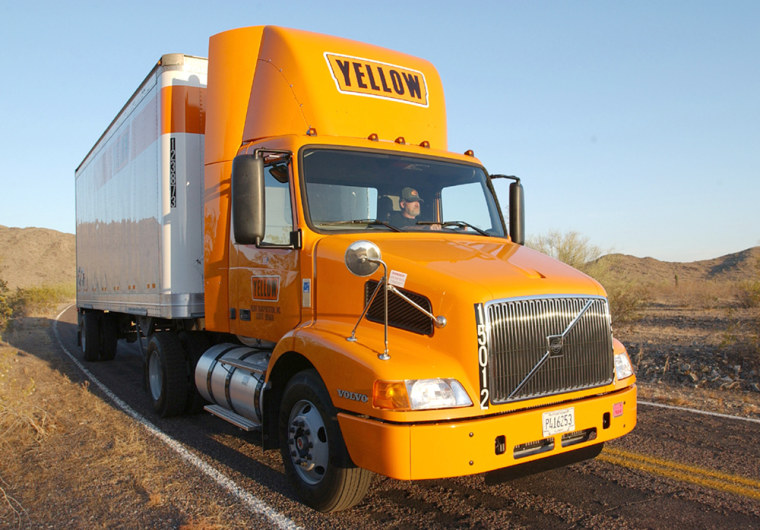Peter Bennison, vice president of Waste Management & Recycling Products Inc., has been having a problem.
Lately it's been a challenge to get his Scotia company's products picked up by trucking companies. He doesn't know why, but the end result is inefficiency. Equipment that should have been moved out of the warehouse sits on the floor. It takes up space that should be used for getting the next shipment ready.
Bennison's problem could become more common if a shortage of truck drivers the American Trucking Association (ATA) documented in a May 2005 report gets worse.
Eighty-five percent of American products move by truck, according to industry figures. When trucks don't move, production bottlenecks and costs increase.
The ATA estimates annual demand for truck drivers outpaces supply by about 20,000 drivers, or 1.5 percent of the 1.3 million long-haul truck drivers working in the United States.
The number of long-haul truckers needed in the United States will hit 1.62 million by 2014, the same time 219,000 drivers hit retirement age. The industry says it will need 539,000 new truck drivers over the next nine years.
New York--where 1997 federal figures say 40,674 people work for 3,929 trucking businesses--shares in this shortage, said William Joyce, president of the New York Motor Truck Association. He can't put numbers on the New York trucker deficit, but anecdotal information says it is there.
"There is definitely a shortage. There's no question about it," said Paul Montarello, president of Priority Transport in Schenectady.
Montarello said that when he started in the business 33 years ago, it was easier to find drivers. Today there are other options for young workers.
Saratoga Transportation Inc. works hard to keep driver turnover to a minimum and aggressively hires new drivers, said Bob Farley, the firm's vice president of operations.
"Our turnover rate as of May of this year was about 70 percent, which is about 30 percent below the industry standard," Farley said. "We have now gotten our turnover rate down to 40 percent and we feel pretty comfortable it is going to go lower."
Saratoga Transportation cut attrition by ensuring a minimum driver salary of $42,000 plus benefits for the 130 full-time drivers, and increasing mileage drivers are eligible for. With more miles, some drivers are making $80,000 annually.
The company also made management more accessible. That lets the drivers share frustrations such as safety issues and traffic in the New York metropolitan area. The goal is to make the drivers feel they're part of the company.
"It's strictly supply and demand. These drivers know they can walk out of here tomorrow and get a job with any number of carriers that are supplying the Wal-Marts and the Targets," Farley said.
Getting the 'right' drivers
At Con-Way Central Express in Albany, the local branch of Ann Arbor, Mich.-based Con-Way Transportation Services, the goal is to get the "right" truck drivers, said personnel supervisor Patrick Doran. The local terminal has 50 drivers.
The company runs an apprenticeship program to train new drivers, and encourages current drivers to recruit. Con-Way pays $200 for every new driver.
Recruiting is easier because Con-Way focuses on pickup and delivery for the most part, along with some short line-haul runs.
"We pay very well, and our drivers are home on the weekends," Doran said.
Industry research indicates that the major reasons drivers leave the business, or get out of the long-haul trucking side of it, are the days, and sometimes weeks, away from home.
Nationally, Con-Way employs 20,000 drivers. Company policy is to get drivers home on weekends as a retention tool, said company spokesman Joseph DeLuca.
The company runs a driver's school in Boston to train drivers in the Northeast. While Con-Way faces a driver "pinch" in some parts of its system, its benefit package and weekend-at-home policy means the Northeast isn't one of those places, DeLuca said.
Ken Downing, vice president of Albany Transport, a local hauling company, said his 45 drivers stick around because they are home every night. He also pays well.
"We have taken care of the people pretty well over the years," Downing said. "Our compensation package is as high as any in the Capital District."
New York's trucker recruitment situation is complicated by the idiosyncrasies of New York driving, Joyce said. Recruiting ads run by many firms often prominently display a notice that drivers will not be required to drive in New York City, he said.
Training drivers to fill the shortfalls is the job of Harry Kowalchyk, president of the National Tractor Trailer School in Syracuse. Kowalchyk's school feeds trucking companies across the Northeast.
There are hundreds of job openings for truck drivers, he said. Young people with families aren't attracted to the long periods away from home. However, a surprising number of older workers who have retired, or been displaced from another job, are taking up trucking.
"Who is today's typical driver? I don't think there really is one," Kowalchyk said.
One student holds an MBA and was president of his Keuka College class. Another student is a scientist formerly at Bristol Myers. IT workers who lost jobs as their work was outsourced are learning to be truck drivers, Kowalchyk said.
Brute strength is no longer required, so trucking is open to women, although the dominant demographic is still white male.
The industry is aggressively going after ex-soldiers and Marines, Kowalchyk said. Somebody who muscled a supply truck along Iraqi highways is a perfect candidate, he said.
© 2006 The Business Review (Albany)
